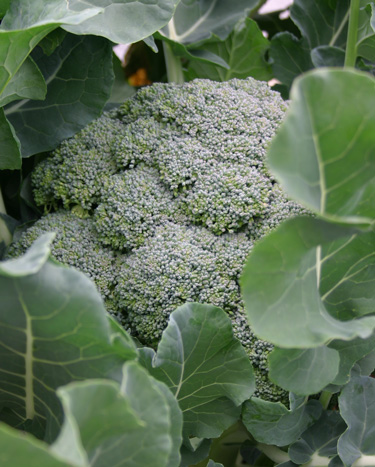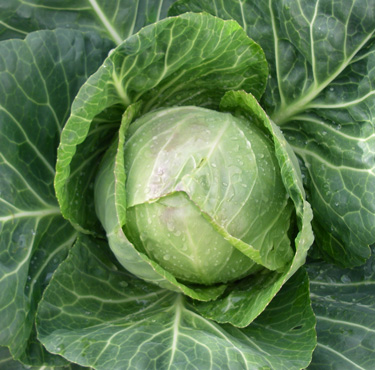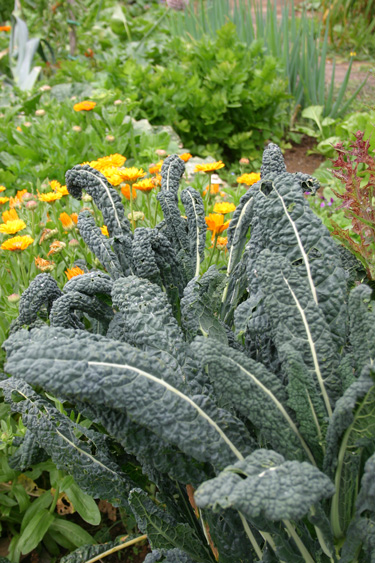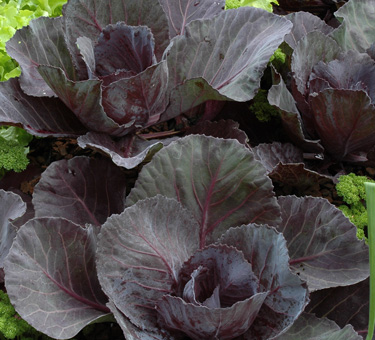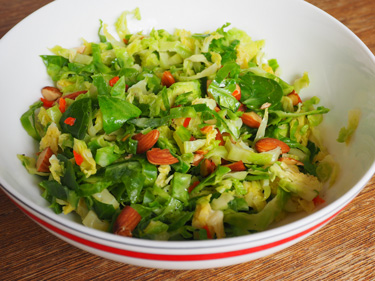Grow your greens
They're among winter's most powerful health foods, especially when you grow your own. Kale, cabbage, cauliflower, cavolo nero, broccoli, broccolini and Brussels sprouts reach peak flavour when chilly weather causes their sugar content to rise. Winter’s the time to enjoy the nutrient rich veges we call brassicas.
All are descended from one plant species. The original brassica, Brassica oleracea (‘wild cabbage’) still grows wild on the limey cliffs of Europe, adapted to its harsh environment with thick fleshy leaves that store water and nutrients.
May is still mild enough to plant out winter veges in many areas. Depending on the weather, some will be ready to eat in June or July. Others will be ready for harvest in early spring.
Chinese cabbages, mustard and kale are quick to grow as microgreens or slightly larger, as a ‘cut and-come-again’ crop. Snip the young leaves for a stirfry or add them in the last few minutes to a slow cooked casserole. Mustard is hot like wasabi and best in small doses, but the young leaves add a delicious tang to salads. Giant Red Mustard is often grown for its striking colour and form.
Kale and cavolo nero are the most similar to wild cabbage with a non-heading growth habit and heavily textured leaves. These excellent dark green vegetables are increasingly valued for their pungent flavour and highly nutritious leaves.
Globe cabbages, cauliflowers and Brussels sprouts take longer to reach maturity. To grow them well you need deeply dug, well drained soil with compost and lime added. Ideally they’re planted in autumn, early enough to be well established before the coldest weather slows their growth. Young seedlings need protection from frost. Cloches and tunnel crop covers come in very handy at this time of year.
Broccoli is one green most children will eat and the superior flavour of home grown broccoli can be astounding. Sprouting broccoli is a useful thing to have in the garden. Plants carry on producing side shoots long after the central head has been picked. Regular picking encourages more to grow.
7 great reasons to grow and eat brassicas
- Brassicas eaten straight from the garden are the most nutritious, because the longer they hang around on shop shelves (or in the fridge), the more nutrients are lost.
- They’re packed with essential nutrients, including vitamins C (burns fat and purifies blood), K (strengthens the immune system), and B (for energy and healthy metabolism).
- They help prevent cancer and heart attacks.
- They assist with weight loss when included in a healthy diet.
- They promote healthy skin, eyes and muscle tone.
- They contain omega 3, essential fatty acids.
- Anthocyanin – the colour in red cabbage, is a powerful antioxidant believed to be helpful in preventing Alzheimer's disease.
Success with Brassicas
Timing
Brassicas love a cool growing season, and are ideally planted in autumn or early winter. They taste sweeter after a frost, but plants will perish if the roots freeze. Newly planted seedlings need protection in coldest weather. A 5-10cm blanket of organic mulch helps insulate the roots. Use a cloche or row cover to protect young crops from freezing air.
Location
Brassicas need sun and well-drained garden soil or raised beds. To avoid soil borne diseases, try not to plant them in the same soil two years running. A three or four year rotation is ideal.
Soil prep
Prepare the soil well, digging in plenty of compost. Plants grown in a healthy soil, rich in organic matter, are better able to uptake the nutrients they need, and are therefore more resistant to pests and diseases. Well-rotted animal manures, sheep pellets or blood and bone may also be mixed into the soil prior to planting.
Liming
Lime is added to lower soil acidity and maintain the pH at around neutral 6.5 to 7.5. This is also known as ‘sweetening the soil’. The right pH ensures efficient nutrient uptake and also helps deter clubroot disease. Autumn is the best time to apply lime, ideally a few weeks before planting. How much lime you should apply depends on your soil’s existing pH and a home test kit will tell you this. But most NZ soils are naturally on the acidic side and it is safe to assume that application rates recommended on the packaging will make a difference, especially if you have not applied lime recently.
Planting
Plant seedlings carefully and water them well. For a continuous harvest, plant seedlings every few weeks. Planting a range of different varieties is another way to spread your harvest. Punnets of mixed brassica seedlings are available for small families. They will start growing more quickly if you take care not to damage the roots when transplanting seedlings. For this reason, seedlings grown in cell packs are a good idea.
Mulching
A thick layer of straw or other organic mulch helps to keep moisture in, weeds out, and protect roots from frost.
Watering
Aim to keep the soil evenly moist. An erratic water supply can lead to split cabbages.
Feeding
As the crop grows, feed every few weeks with a balanced liquid fertiliser or a light side dressing of general garden fertiliser. Starting when plants are 10 to 15cm tall, they’ll grow faster if feed them every month or so, especially if you want your broccoli plants to keep sprouting after the main head has been picked.
Brassicas need nitrogen for growth, but also plenty of potassium. Some gardeners swear by blood and bone used in conjunction with potash. Organic sources include sheep pellets, dried blood, comfrey, fish and seaweed fertilisers, and some very effective ‘organic based’ products that boost growth while conditioning the soil. Brassicas evolved from a seaside plant, so it’s not surprising that they thrive on seaweed!
Pest watch
Be ready for slugs and snails, which come out in force in cool moist weather. Thankfully white butterflies decline in winter, but it’s been a bad summer for this major pest. The caterpillars hatch from eggs laid on the undersides of leaves and quickly grow as they chomp bigger and bigger holes in the leaves, completely ruining young plants. It’s important act early before serious damage is done. Some gardeners keep numbers down by picking the caterpillars off the leaves. Derris dust is an old fashioned remedy still in use, but it is toxic especially to bees. One useful alternative is Yates Nature’s Way Caterpillar Killer, which contains a naturally occurring bacteria lethal to caterpillars. Diatomaceous earth is another natural control option. Covering the crop with insect mesh to keep butterflies off young plants is very effective, especially during a warm autumn, when butterflies are still very active.
Rhubarb and cabbages
Rhubarb is highly regarded as an excellent planting companion for brassicas. One old fashioned practice is to bury rhubarb leaves below crops to help prevent clubroot disease.
In the Kitchen
For anyone turned off winter greens in childhood, overcooking has got to be the number one culprit. Think slushy grey Brussels sprouts! Overcooking not only makes them unappetising, it depletes the nutritional content. A minute or two is all it takes to steam a sweet crunchy side dish, which won’t leave that lingering boiled cabbage odour.
The most delicious way to eat pungent dark greens such as kale, is to first stirfry loads of garlic in butter or oil, being careful not to burn it. Then add thoroughly washed leaves and continue stirring over high heat until the water has evapourated but the leaves are still colourful and crunchy.
Veges to plant in May
Cold areas:
Bok choi,
broccoli,
Brussels sprouts,
cabbage,
carrots,
cauliflower,
cress,
giant red mustard, kale,
winter lettuce,
mesclun mix, mizuna, mustard, onions,
pak choy,
radishes,
silver beet,
spinach,
winter lettuce.
Warm areas:
Beetroot, bok choi, broad beans, broccoli, Brussels sprouts, cabbage, carrots, cauliflower, celery, cress, giant red mustard, leeks, mesclun mix, mizuna, onions, pak choi, parsnip, peas, radishes.
14-May-2015


